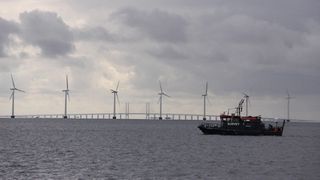Remote technologies drive the maritime industry
No one onboard

When it comes to industries undergoing large-scale digital transformation, the maritime industry may not be the first that springs to mind. However, from the adoption of blockchain technology to advancements in offshore wind operations, developments in marine conservation and beyond, remote technology is opening up new ways of maritime working.
One of these advancements includes the accelerated design and manufacturing of uncrewed surface vessels (USVs) that can undertake tasks from the ocean’s surface while being controlled onshore from a remote operations center (ROC). USVs are starting to replace some technologies used across the marine sectors but, even more excitingly, they are creating possibilities for completely new ways of working based on automated technology.
With a wide range of oceanographic applications, including research, surveillance, and marine exploration, USVs can transform the industry’s work environment. These applications can start to reduce reliance on larger vessels, enabling marine organizations to become more agile.
Increased safety and efficiency
Conducting remote operations with USVs brings many benefits to the maritime industry, one of the biggest of which is the huge reduction in risk for maritime personnel. The ability to deploy and manage remote vessels from ROCs anywhere in the world means far fewer people need to work in the extreme and potentially hazardous offshore environment.
Take critical industry tasks such as transoceanic cable route surveys, which are vital for meeting the increased demand for data communications. The introduction of USVs allows these tasks to be completed with minimal health and safety risk, and with significant operational savings when compared to executing the same task with crewed vessels. In addition, USVs offer an extremely efficient mode of data collection, allowing maritime organizations to acquire better analytics for business intelligence, providing deeper insights and therefore better advise to their clients.
As USVs help staff transition their careers from offshore to onshore, organizations are increasingly better equipped to optimize their teams using cloud computing and optimized IT infrastructure. With the deployment of remote technology, staff can prioritize complex analytical tasks rather than spending time supporting the delivery stages. This leads to another advantage: increased output and speed of delivering insights to clients.
A key point to note is that the technology does not replace the need for skilled personnel; rather, it allows them to work more efficiently and within a safer environment. Staff who transition from offshore to onshore have a crucial part to play in analyzing the data collected by the USVs, distilling the information and making recommendations to clients. USVs and improved ship-to-shore connectivity allow them to do this without long periods of time spent offshore, exposed to potentially dangerous conditions.
Are you a pro? Subscribe to our newsletter
Sign up to the TechRadar Pro newsletter to get all the top news, opinion, features and guidance your business needs to succeed!
Greener technology and sustainable solutions
Alongside improved operations, increased sustainability is essential to the future of the maritime industry. The UK Government’s Maritime 2050 roadmap has set an ambitious target of zero emission ships globally by 2050, meaning that organisations are having to make big changes routed in advanced technologies to align with this policy and the changes in legislation that are likely to follow.
The integration and adoption of USVs over traditional marine vessels will significantly benefit the overall environmental impact of marine expeditions and operations. Some USVs have hybrid diesel-electric engines that allow the vessel to operate further offshore for a longer period, whilst also significantly lowering the carbon footprint. More operational USVs will lead to fewer of the larger, more polluting vessels, a huge step forward in bettering long-term sustainability in the maritime industry.
Designing remote operations at scale
At Fugro, we believe that USVs will play a prominent role in the future of maritime exploration and operations and, as such, we have partnered with SEA-KIT International, a global provider of hi-tech solutions to maritime and research industries. Through this partnership, we are helping to drive the development of USVs to support greater use of remotely operated vehicles (ROVs) and autonomous underwater vehicles (AUVs) to inspect marine assets. Developed with SEA-KIT, our new range of USVs will consume up to 95% less fuel than traditional vessels, supporting international ambitions for zero global emissions in the maritime industry.
Everyone in the maritime industry will significantly benefit from the uptake of remote technology. These changes will help to bring about faster, more efficient and safer marine operations, functioning on a significantly more sustainable scale, and also accelerate the maritime industry’s important digital transformation.
- Ivar Josselin de Jong, Director of Remote Inspection market for O&G and Renewables with the Sea-Kit and Electric ROV Solution at Fugro.
- We've featured the best cloud storage.
Ivar drives Fugro’s role in the Remote Inspection market for O&G and Renewables with the Sea-Kit and Electric ROV Solution. He has over 24 years of working experience.

